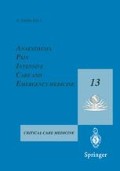Abstract
In most cases, the metabolic disorders of acid-base homeostasis are helpful to highlight the main or associated diagnosis in the critically ill. As the physiopathology and the diagnostic aspects are fully covered elsewhere in these proceedings, it seems reasonable to focus here only on the monitoring value of the metabolic derangements of blood gas analysis (BGA) and on some controversial aspects of therapeutics.
Access this chapter
Tax calculation will be finalised at checkout
Purchases are for personal use only
Preview
Unable to display preview. Download preview PDF.
References
Narins RG, Emmett M (1980) Simple and mixed acid-base disorders: A practical approach. Medicine S9:161–187
Narins RG, Jones ER et al (1982) Diagnostic strategies in disorders of fluid, electrolyte and acid-base homeostasis. Am J Med 72:469–512
Schiraldi F (1995) Time to abandon base excess as a reliable index in the ICU? Int J Int Care 2:23
Zhang H, Vincent JL (1993) Arteriovenous differences in PCO2 and pH are good indicators of critical hypoperfusion. Am Rev Respir Dis 148:867–871
Bircher NG (1992) Acidosis of cardiopulmonary resuscitation: Carbon dioxide transport and anaerobios. Crit Care Med 20;9:1203–1204
Van der Linden P, Rausin I et al (1995) Detection of tissue hypoxia by arterio-venous gradient for PCO2 and pH in anesthetized dogs during progressive hemorrhage. Anesth Analg 80: 269–275
Kette F, Weil MH et al (1993) Intramyocardial hypercarbic acidosis during cardiac arrest and resuscitation. Crit Care Med 21:901–906
Adrogué HJ, Rashad MN, Gorin AB et al (1989) Assessing acid-base status in circulatory failure. Differences between arterial and central venous blood. N Engl J Med 320:1312–1318
Schlitig R, Pinsky MR (1991) Defining the hypoxic threshold. Crit Care Med 19:147–149
Vincent JL, Dufaye P et al (1983) Serial lactate determinations during circulatory shock. Crit Care Med 11:449–451
Mahutte CK, Jaffe MB et al (1991) Cardiac output from carbon dioxide production and arterial and venous oximetry. Crit Care Med 19:1270–1277
American Heart Association (1994) Textbook of Advanced Cardiac Life Support
Stacpoole PW, Harman EM et al (1983) Treatment of lactic acidosis with dichloroacetate. N Engl J Med 309:390–396
Stacpoole PW, Wright EC et al (1992) A controlled clinical trial of DCA for treatment of lactic acidosis in adults. N Engl J Med 327:1564–1569
Arieff AI (1993) Managing metabolic acidosis: Update on the sodium bicarbonate controversy. J Crit Illness 8:224–229
Rhee K, Toro LO et al (1993) Carbicarb, sodium carbonate, sodium chloride in hypoxic lactic acidosis. Chest 104:913–918
Adrogué HJ, Madias NE (1998) Management of life-threatening acid-base disorders. II parts. N Engl J Med 338;1:26–34, 338;2:107–111
Gabow P (1985) Disorders associated with an altered anion gap. Kidney Int 27:472–483
Smithline N, Gardner KD (1976) Gaps — anionic and osmolal. JAMA 236:1594–1597
Faber MD, Kupin WL et al (1994) Common fluid-electrolyte and acid-base problems in the intensive care unit: Selected issues. Semin Nephrol 14(1):8–22
Adroguè HJ, Madias NE (1981) Changes in plasma potassium concentration during acute acid-base disturbances. Am J Med 71:456–467
Steiner RW (1984) Interpreting the fractional excretion of sodium. Am J Med 77:699–702
Laterre PF, Mallie JP (1993) The fractional excretion of chloride instead of sodium indicates hypovolemia: A comparative study of bedside assessment of true or effective intravascular depletion. Clin Intens Care 4:112–115
Idris AH, Staples ED et al (1994) Effect of ventilation on acid-base balance and oxygenation in low blood-flow states. Crit Care Med 22:1827–1834
Rimmer JM, Gennari FJ (1987) Metabolic alkalosis. J Intensive Care Med 2:137–150
Gennari FJ (1998) Current concepts: Hypokalemia. N Engl J Med 339;7:451–458
Kamel KS, Ethier JH et al (1990) Urine electrolytes and osmolality: When and how to use them. Am J Nephrol 10:89–102
Seldin DW, Rector FC (1972) The generation and maintenance of metabolic alkalosis. Kidney Int 1:306–320
Madias NE, Cohen JJ, Adrogué HJ (1990) Influence of acute and chronic respiratory alkalosis on preexisting chronic metabolic alkalosis. Am J Physiol 258:F479–F485
Tomsic M, Horvart M (1991) Torsade de pointes associated with combined severe metabolic and respiratory alkalosis. Clin Int Care 2;1:47–50
Author information
Authors and Affiliations
Editor information
Editors and Affiliations
Rights and permissions
Copyright information
© 1999 Springer-Verlag Italia
About this paper
Cite this paper
Schiraldi, F., Ferraro, P., Paladino, F. (1999). Metabolic Acidosis and Metabolic Alkalosis in the Critically Ill. In: Gullo, A. (eds) Anaesthesia, Pain, Intensive Care and Emergency Medicine — A.P.I.C.E.. Springer, Milano. https://doi.org/10.1007/978-88-470-2145-7_41
Download citation
DOI: https://doi.org/10.1007/978-88-470-2145-7_41
Publisher Name: Springer, Milano
Print ISBN: 978-88-470-0051-3
Online ISBN: 978-88-470-2145-7
eBook Packages: Springer Book Archive

